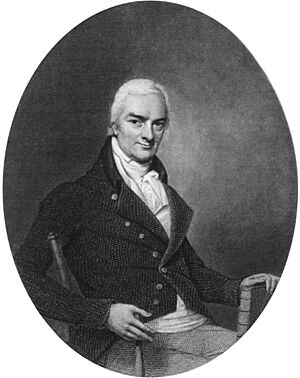John Haygarth facts for kids
John Haygarth (born 1740, died 1827) was an important British doctor from the 1700s. He found new ways to stop illnesses like fever from spreading. He also helped to lower the number of deaths from a serious disease called smallpox.
Life Story
John Haygarth was born in 1740 in a place called Garsdale, near Sedbergh, in England. His parents were William Haygarth and Magdalen Metcalfe.
He went to Sedbergh School and later studied medicine at the University of Edinburgh Medical School. He also studied at the University of Leiden and in London. In 1766, he earned his medical degree from the University of Cambridge. After that, he became a doctor at the Chester Infirmary.
In 1776, John Haygarth married Sarah Vere Widdons. They had six children together.
Medical Discoveries
John Haygarth worked in Chester for 30 years and became a very respected doctor. He was interested in many medical topics, especially how to treat patients with fever and how to prevent smallpox.
In 1774, he did a survey in Chester to learn about people's health. He found that most people had already had smallpox. He also realized that sick people with fevers should be kept separate from others. He wrote about these findings in a paper.
In 1778, Haygarth helped start the Smallpox Society of Chester. This group encouraged people to get inoculated against smallpox. Inoculation was a way to give someone a mild form of the disease to protect them from a worse one. This idea was not very popular at first.
Thanks to their efforts, the number of deaths from smallpox in Chester dropped by almost half in just four years! Other towns like Leeds and Liverpool soon started using Haygarth's methods. He wrote a book called Inquiry how to Prevent the Small Pox in 1784. This book was translated into other languages and made him famous around the world.
Haygarth also kept working on how to treat fever patients. He did experiments and found that separating fever patients in hospitals helped more of them get better. In 1783, Chester opened the first fever wards in Britain. Almost all the fever patients there recovered. The next year, his methods helped stop the spread of typhus in the town.
In 1798, Haygarth moved to Bath. He continued his research and wrote about conditions like rheumatic fever and gout. He also believed that everyone should have access to free education.
The Power of Belief
In 1799, John Haygarth looked into something called "Perkins tractors." These were metal tools that people claimed could "pull out" diseases from the body. They were very expensive.
Haygarth wanted to show that these expensive tools were not needed. He did an experiment where he used fake wooden tractors that looked like the real metal ones. He found that the wooden tractors worked just as well as the expensive metal ones!
This experiment showed how much the mind can affect the body. It proved that simply believing you are getting better can help you heal. This idea is now known as the placebo effect. Haygarth realized that this is why famous doctors might seem more successful. He even thought that much of the medicine at the time relied on this power of belief.
Later Life and Legacy
John Haygarth passed away on June 10, 1827, near Bath. He was buried in a church in Swainswick. A special ward at the Chester Infirmary was named after him. A medal was also created in his honor for the best nurse at the hospital.
See also
- Royal Commission on Animal Magnetism


